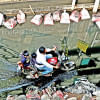Dhaka’s canals cannot be saved without decisive leadership

The crisis surrounding Dhaka's rivers, ponds and open spaces has been repeatedly highlighted in recent years. A new study by the River and Delta Research Centre (RDRC) now turned the spotlight on canals, which are fast disappearing thanks to encroachment, unplanned urbanisation, and negligence from the authorities. According to the study, Dhaka has lost a staggering 120 kilometres or 307 hectares of canals—which is more than the distance between the capital and Mymensingh city—over the past 80 years. Researchers compared the 1880-1940 land survey, known as the Cadastral survey, with satellite images from 2022 before concluding that some 95 canals have been completely lost or reduced to less than half of their original length.
In other words, 55 percent of the land occupied by canals and river channels during the Cadastral survey has been lost by now. Even though successive governments have excavated 10 major canals and created four new lakes, it was nothing compared to the critical loss of water bodies that Dhaka continues to suffer to this day, as various reports have shown. If the trend holds, it may not be too far into the future that these once-treasured features of the city would cease to exist, at least in the way they were intended to.
The question is, how long before we realise the gravity of this situation? How long before we say, "enough is enough"? Canals, like other waterways, are vital for our existence. They serve as lifelines for local communities, facilitating drainage, supporting ecosystems, and contributing to the overall well-being of the people. But the encroachment and filling of these waterways with structures, farmland, and streets have exacerbated flooding, waterlogging and environmental degradation.
Often, this happened at the behest of the government itself. As a recent Rajuk survey showed, 68 public ponds within its jurisdiction alone have been illegally occupied and filled up by individuals and government organisations. Many canals also had to go through the same fate, as did many riverbanks, low-lying areas and open spaces.
While the canals that disappeared may not be recovered, preserving or restoring the ones that still exist is possible, experts say. We think this is where we must urgently focus on. A key challenge in this regard is the lack of specific authorities for many canals and the prevalence of collusion among land grabbers, responsible officials, and politicians that often enable encroachment. We must break this cycle. It will require decisive leadership, effective policies and strict enforcement, as well as active participation from all stakeholders.


 For all latest news, follow The Daily Star's Google News channel.
For all latest news, follow The Daily Star's Google News channel. 











Comments